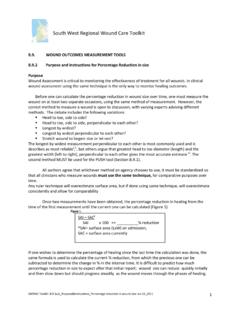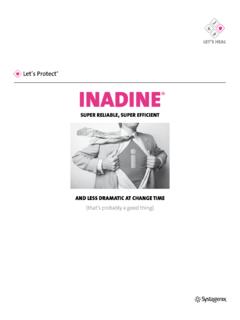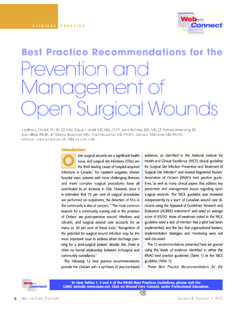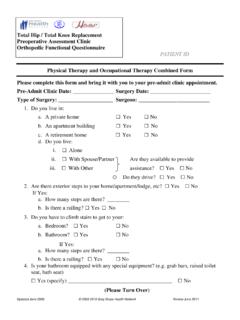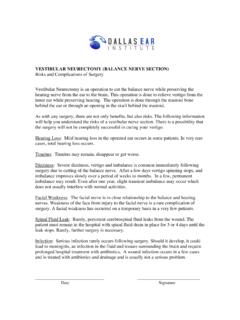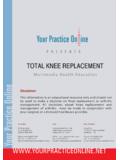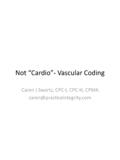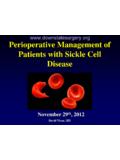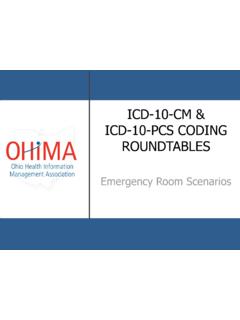Transcription of Local Wound Care: Cleansing - Health Services for …
1 South West Regional Wound care Toolkit SWRWC Toolkit: Wound care Cleansing_Jun_15_2011 1 Local Wound care : Cleansing Purpose This section, along with the Wound Cleansing Algorithm (Section ) are intended to provide information about the types of Wound Cleansing currently being performed, and the deciding factors in choosing which method is correct for the Wound . Wound Cleansing Information Blunt (2001)i has described routine Wound Cleansing as being ritualistic, rather than based on research evidence or the principles of Wound healing. The clinician needs to determine what the Wound characteristics are before deciding which method of Cleansing , and which solution is needed. The purpose of Wound Cleansing is to remove foreign bodies such as organic or inorganic debris, inflammatory contaminants and bacteria, devitalized tissue and excess exudate, all of which can become a cause of infection , ii.
2 Effective Cleansing removes these harmful materials from the Wound surface, without causing trauma to the healthy cells. The Wound can then be assessed and the Wound dressing applied, creating the optimum environment for the Wound healing. Solutions Normal Saline is preferred for Cleansing because it is isotonic (physiologic), non toxic and inexpensive iii. Sterile water is needed to activate the silver in metallic/ nanocrystalline silver dressings, but not ionic silver dressings. Tap water is a Wound Cleansing agent commonly used in some community settings and hospitals. The practice has recently been reviewed in a Cochrane review iv. The decision to use tap water to cleanse wounds should take into account the quality of water ( drinkable, municipality treated or untreated well water), the severity of the Wound and the patient s general condition, including the presence of co morbid conditions that increase risk of infection.
3 In addition, the method of getting the tap water to the Wound should be considered in making a decision, particularly in homes where hygiene concerns exist. Commercial Wound Cleansers: Wound cleansers are another method of Cleansing wounds. They must be differentiated from skin/ perineal cleansers, which are meant for non broken skin to provide waterless bathing or perineal Cleansing after urinary or fecal incontinence. Cleansers contain a variety of ingredients, including some agents that prevent the growth of bacteria, or surfactants which help to lift foreign materials from the Wound or skin surface. These are described as having a toxicity index; one part of the cleanser must be diluted with x parts of water to make the solution non toxic to healthy cells. The least toxic are 1:10, the most toxic are 1:1000 for non antimicrobial cleansers v. There is concern that the utilization of cleansers that are toxic may contribute to delayed healing due to damage to healthy cells.
4 South West Regional Wound care Toolkit SWRWC Toolkit: Wound care Cleansing_Jun_15_2011 d Temperature of Solution Fluids used for Cleansing wounds should be warmed to at least room temperature, although body temperature would be even more When a cold solution is used for Wound care , and the temperature of the Wound drops to below 37 , mitotic activity is delayed by up to 4 hours, vii there is an inhibition of the ability of macrophages to work effectively and the leukocyte activity reduces to zero. There has been documented evidence that the incidence of sepsis is higher when the Cleansing solution is not Cleansing Techniques i) Swabbing/ Scrubbing: Swabbing a Wound redistributes the bacteria, viii traumatizes new granulation tissue by causing micro abrasions, ix and sheds fibers which can contribute to the formulation of granulomas in the Wound .
5 Ii) Compressing/ soaking: Soaking the foot in a basin of water to clean the Wound should never be done with diabetic foot ulcers, because it softens skin that already has decreased production of oils and elastin, reducing the tensile strength of the periwound tissue, and can introduce bacteria into the Wound . Compressing or soaking of larger areas of necrotic tissue debris may help to soften or loosen the necrotic tissuex. However, soaking the Wound or using non therapeutic low pressure increases the permeability of the tissue, increases bacterial counts, and does not effectively clean the Wound bedxi. iii) Irrigation/ Flushing A 35ml. syringe (only 30ml. available in Canada) with a 19 gauge blunt needle approximately two cm above the Wound delivers approximately 8 psi, when the plunger is depressed at maximum force (Rodeheaver 2007). There are commercially available pre filled irrigation bottles containing 118 mls.
6 Normal Saline that are reported to provide this PSI, and are a lower cost than that of the syringe and Wound tip or needle. If a Wound is friable and bleeds easily, a lower force should be used. Pressures higher than 15 PSI will force surface bacteria and debris deeper into the Wound with deleterious effects (Stevenson et al. 1976)xii. Volume of solution There is no general agreement on the volume of solution that should be used. The RNAO Best Practice Guidelines for Pressure Ulcers advises that to achieve adequate Cleansing of the Wound bed, a sufficient volume of irrigation fluid is critical, and suggests between 100 150 ml of solution. However, the panel emphasizes that the amount used should be enough to adequately rinse the entire surfacexiii, but this would be dependent on the size and status of the Wound . Miller and Gilchrist (1996)xiv suggested an irrigation volume between 250ml and 500ml although Stevens et al.
7 S 1976 work specified a volume of 150 ml. The old adages that apply to Wound Cleansing are flush until returns are clear and the solution to pollution is dilution x. Universal Precautions Delivering the solution at a 45 angle will decrease the chance of splashback of the irrigation solution. Protective devices to protect eyes, face and clothes of the clinician should be utilized as per universal precautions. iv) Sitz Bathing: Commonly used in anorectal/ gynecological disorders, there is a lack of RCTs supporting sitz baths to promote faster healing or fewer complications. They may improve peri anal hygiene and relieve discomfortxv. Conversely, they reported that immersing in a tub of water can cause systemic vasodilatation, decreasing the circulation to the perineal area, South West Regional Wound care Toolkit SWRWC Toolkit: Wound care Cleansing_Jun_15_2011 3theoretically delaying healing.
8 Sitz baths are not recommended as an effective method of Wound Cleansing . v) Whirlpool: Where physically possible to provide, there is evidence to support whirlpool therapy for Wound debridement and to increase perfusion to the area, but is not indicated for clean, proliferating wounds. Cleansing by Wound characteristics i) Shallow Wound Cleansing procedure: Regardless of the type of Cleansing needed, you should cleanse from the centre of the Wound in a circular motion, working towards the edges and the surrounding tissues. To decrease the chance of contamination of the Wound centre, do not return to the centre after Cleansing the edge of the Wound or the surrounding tissues x. ii) Wound containing debris or inflammation/externally contaminated/ granulating but not healing /Necrotic wounds healable and debrideable: High pressure irrigation with a force of 7 12 pounds per square inch (psi) will effectively remove inflammatory debris or loosen and soften loose necrotic tissue without damaging the viable tissuexvi.
9 Iii) Healthy epithilializing wounds: Do not need aggressive Cleansing as it may remove growth factors necessary for healing, and traumatize the surfacexvii. Use low pressure (4 7 PSI) by pouring the solution over the Wound with enough fluid to adequately rinse the entire surfacex. These wounds would benefit from leaving dressings intact for 7 21 days with a clear dressing type tegaderm acrylic or telfa clear. iv) Healthy granulating wounds reducing 20 30% in size in 3 4 weeks: High pressure irrigation (8 15 PSI) is NOT recommended for healthy proliferating wounds because fragile blood vessels and new tissue can be damaged. x, xvii Healing wounds without debris or infection should be gently cleansed with non cytotoxic solutions such as normal saline or non ionic surfactant cleansers, warmed to room temperature, at low pressure of less than 8 psi, obtained by pouring the solution over the Wound to protect granulating tissue, with enough fluid to adequately rinse the entire surface.
10 Do not use antimicrobial solutions for healthy granulating wounds. v) Deep Wound with tunneling or undermining: Use a small lumen catheter 5 Fr (Rodeheaver 2004) & a 35 cc. syringe to irrigate wounds with tunneling or undermining which cannot be managed using the 30 cc syringe/ 18 g angio systemxviii. Use a catch basin and towels to catch and absorb the returns. Fill a syringe with Cleansing solution. While holding a basin below the Wound (not touching the Wound edges) empty syringe filled with Cleansing solution into the Wound , making sure that all areas are covered and any debris is loosened and removed. Repeat 2 3 x if needed. Do not touch the Wound with the tip of the needle or angiocath. Be sure to irrigate any undermined areas or sinus tracts using a catheter with a syringe to cleanse the tissues that are not visible. Flush with large amounts of solution.

